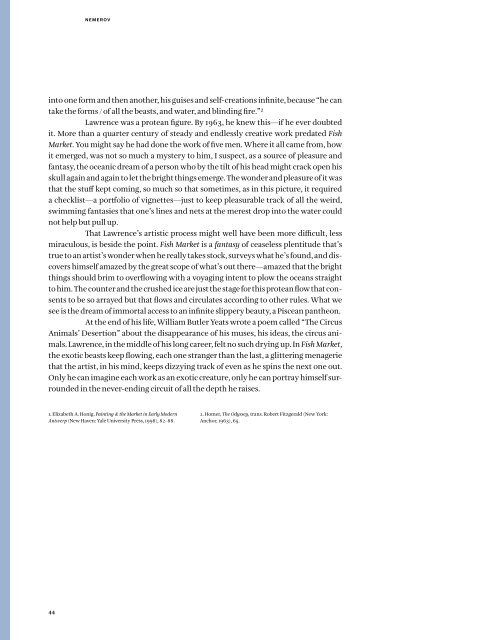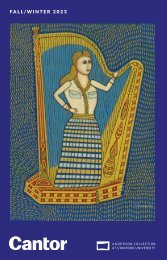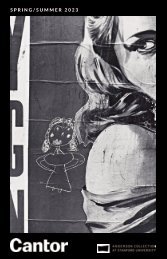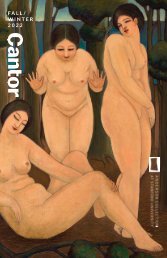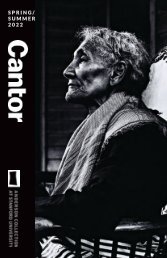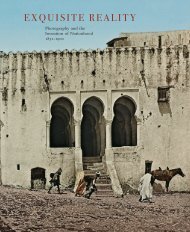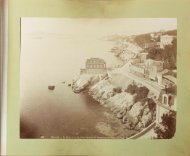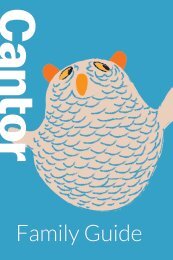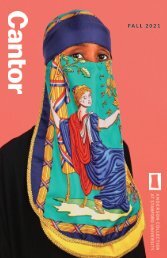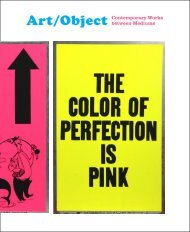Exhibition Catalog | Jacob Lawrence
Explore a gift of drawings, prints, and paintings by African American modernist Jacob Lawrence addressing Black history and civil rights, public life, faith, and creativity.
Explore a gift of drawings, prints, and paintings by African American modernist Jacob Lawrence addressing Black history and civil rights, public life, faith, and creativity.
You also want an ePaper? Increase the reach of your titles
YUMPU automatically turns print PDFs into web optimized ePapers that Google loves.
NEMEROV<br />
into one form and then another, his guises and self-creations infinite, because “he can<br />
take the forms / of all the beasts, and water, and blinding fire.”²<br />
<strong>Lawrence</strong> was a protean figure. By 1963, he knew this—if he ever doubted<br />
it. More than a quarter century of steady and endlessly creative work predated Fish<br />
Market. You might say he had done the work of five men. Where it all came from, how<br />
it emerged, was not so much a mystery to him, I suspect, as a source of pleasure and<br />
fantasy, the oceanic dream of a person who by the tilt of his head might crack open his<br />
skull again and again to let the bright things emerge. The wonder and pleasure of it was<br />
that the stuff kept coming, so much so that sometimes, as in this picture, it required<br />
a checklist—a portfolio of vignettes—just to keep pleasurable track of all the weird,<br />
swimming fantasies that one’s lines and nets at the merest drop into the water could<br />
not help but pull up.<br />
That <strong>Lawrence</strong>’s artistic process might well have been more difficult, less<br />
miraculous, is beside the point. Fish Market is a fantasy of ceaseless plentitude that’s<br />
true to an artist’s wonder when he really takes stock, surveys what he’s found, and discovers<br />
himself amazed by the great scope of what’s out there—amazed that the bright<br />
things should brim to overflowing with a voyaging intent to plow the oceans straight<br />
to him. The counter and the crushed ice are just the stage for this protean flow that consents<br />
to be so arrayed but that flows and circulates according to other rules. What we<br />
see is the dream of immortal access to an infinite slippery beauty, a Piscean pantheon.<br />
At the end of his life, William Butler Yeats wrote a poem called “The Circus<br />
Animals’ Desertion” about the disappearance of his muses, his ideas, the circus animals.<br />
<strong>Lawrence</strong>, in the middle of his long career, felt no such drying up. In Fish Market,<br />
the exotic beasts keep flowing, each one stranger than the last, a glittering menagerie<br />
that the artist, in his mind, keeps dizzying track of even as he spins the next one out.<br />
Only he can imagine each work as an exotic creature, only he can portray himself surrounded<br />
in the never-ending circuit of all the depth he raises.<br />
1. Elizabeth A. Honig, Painting & the Market in Early Modern<br />
Antwerp (New Haven: Yale University Press, 1998), 82–88.<br />
2. Homer, The Odyssey, trans. Robert Fitzgerald (New York:<br />
Anchor, 1963), 65.<br />
44


